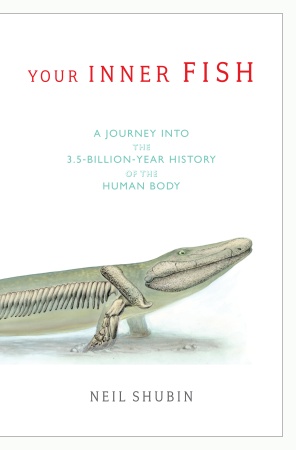
Your Inner Fish: A Journey into the 3.5-Billion-Year History of the Human Body
by Neil Shubin
Sick of hiccups? Blame the fish. And the tadpoles.
As Neil Shubin explains, our long-ago ancestors shared much of our anatomy, and ours is often just a souped-up version of theirs, like “a hot-rod Beetle.” This set-up helps explain many of our modern ailments, from heart disease to hiccups. But Shubin also notes that our ancestors are cause and cure: whatever our problem, understanding our distant animal relatives can provide a solution.
And so Shubin offers a primer on the similarities between mankind and fishkind, revealing that often what we think of as most human about us is also quite fishy. Start with hands, the parts we use, as Shubin put it, “to carry and caress.” Shubin tells of his first encounter with a cadaver and his ability to ignore that it was once a walking, talking man until he glanced at those hands: “…the hand is a visible connection between us; it is a signature for who we are and what we can attain. Our ability to grasp, to build, and to make our thoughts real lies inside this complex of bones, nerves, and vessels.”
The hand seemed to some scientists the perfect invention for mankind, so perfect as to suggest a divine design. But as early as the mid-nineteenth century, Shubin explains, scientists found “exceptional similarities” between the limbs of animals and people. As he writes, “Want to make a bat wing? Make the fingers really long. Make a horse? Elongate the middle fingers and toes and reduce and lose the outer ones. How about a frog leg? Elongate the bones of the leg and fuse several of them together….Despite radical changes in what limbs do and what they look like, this underlying blueprint is always present.” Shubin’s own contribution to this field of study was to discover the fossil of a fish that he and colleagues, along with the help of the Nunavut Council of Elders, named the Tiktaalik. It was “a fish with a wrist,” it could do push-ups, and it was 375 million years old.
Shubin details the development of our various other parts. Eyes, those “windows into the soul,” are similar in every animal with a skull, and ours are derived from those of microbes, jellyfish, worms and flies. The inner ear originated in a primitive jawless fish; our many useless odor-smelling genes are a legacy of mammals that needed better senses of smell (early fish had few of them). Teeth, it turns out, predate jaws, and bodies came to be because of increased oxygen on earth (microbes already had the tools needed to build up). Gonads dropped to the waist from the chest area, where they still reside in sharks, and where they would made “reciting the Pledge of Allegiance a different experience.”
All of these similarities Shubin compresses into easy explanations: how the eye is like a Corvette, how genetic modification is like building a Bozo the Clown (he illustrates with a Bozo family tree), and how the whole of these relationships are like Russian nesting dolls (the biggest doll containing everything with a head and eyes; the smallest containing just us humans). But the most apt metaphor might be the walk through the zoo, which Shubin says reflects our connections to all living creatures, but which also reflects the book itself: ambling, easy and vital.
Excerpt: “The take-home message of many a lawyer joke is that lawyers are an especially voracious kind of shark. Teaching embryology during one of the recurring vogues for these jokes, I remember thinking that the joke is on all of us. We’re all modified sharks – or, worse, there is a lawyer inside each of us.”
Further Reading: The Oxford Book of Modern Science Writing and The Last Human




Send A Letter To the Editors